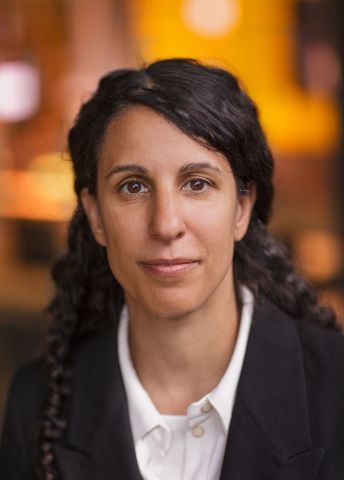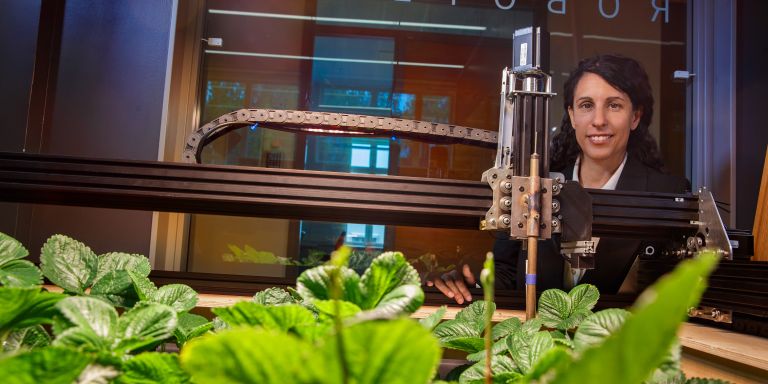
Amy Loutfi
Professor of Computer Science
Wallenberg Scholar
Institution:
Örebro University
Research field:
AI, robotics and human-robot interaction


Wallenberg Scholar
Institution:
Örebro University
Research field:
AI, robotics and human-robot interaction
Loutfi's research field is called embodied AI. Simply put, it involves physical systems, like robots that can interpret and interact with their surroundings using artificial intelligence. Equipped with built-in sensors, these robots can see, hear, and even in some cases detect smells. Some also have manipulate objects as well as move around in the world. These abilities enable AI robots to independently build knowledge about their environment.
As a Wallenberg Scholar, Loutfi aims to enhance the learning abilities of AI robots by drawing inspiration from human cognitive traits. The robots will learn how to perform their tasks using concepts such as curiosity and the ability to play like a child.
“In exploratory play, children develop an understanding of the world around them. When they play, they have a degree of autonomy in their learning. At the same time, they interact with their environment to challenge themselves. I believe learning drivers of this kind could greatly benefit robots,” says Loutfi.
But is it really possible to translate fundamental human traits into code and algorithms?
“I deliberately want to provoke a little by using these words that describe human traits. The goal is not to turn our characteristics into something mechanical. Rather, it is to gain inspiration from how we humans learn about the world around us, and then contribute to the technical foundations of AI” she explains.
AI development has exploded in recent years. Every day sees the launch of new tailored solutions for performing an ever greater variety of automated tasks. But instead of riding this trend, Loutfi wants to take a step back to deepen our understanding of human learning.
“A characteristic feature of my research has always been to see and learn from the way humans interact with each other in their surroundings. In my work on AI and robotics I am inspired by human behavior, while also attempting to identify the aspects of that behavior that can be transferred to intelligent systems.”
She is asking questions about how humans learn to interpret sensory impressions and integrate them with actions, with a view to laying the foundations for a new kind of self-learning machine.
“One interest I have is our ability to create abstractions from the world around us, and how crucial it is for learning. Language enables us to share concepts and phenomena that go beyond our perception of reality – for instance, a zebra with purple wings. Just by saying that, I create an image in your mind, even though there is no such thing,” she explains.
Similarly, she hopes to induce an embodied agent such as a robot to use language and abstract concepts to construct their own goals. Her research team is using the latest AI methods such as machine learning, as well as AI systems like classical or symbolic AI, in which established rules and logic are used to process data.
“When we combine symbolic AI methods with machine learning, we acquire a completely new toolbox. These new tools will enable us to approach the fundamental questions about intelligence and learning.”
The work involves theoretical development and experiments in one of the country’s largest robot labs at Örebro University. The lab resembles a modified industrial unit with a gantry running high along the ceiling. Lining the walls are stations with various types of robot, ranging from humanoid robots to robotic arms, underwater robots, and a large bed for automated cultivation in which strawberries are being grown.
One factor driving me to develop next generation robots is the desire to make the technology available to far more people than is currently the case.
At one of the stations, goal achievement is being trained. For example, the robot is given objects, such as a ball, a cup, and a plate, and asked what it wants to do with them. The robot can reason about the objects, and learn what can be done with them (affordances).
“Maybe the robot wants to place the ball on the plate. We can even use AI to give it the ability to create an image of the result. So, this means robots can set their own goals, and to some extent create an expectation of the result.”
Should the robot fail at achieving the task, a next step is to break down the task into smaller sub-goals that the robot can confirm step by step. It is a kind of curriculum learning. If it misses any of the goals, it should be able to adjust and create new sub-goals on its own. This enables the robot to break down a difficult task into several easier ones, so it can essentially practice until it is better able to achieve the overall task.
“This can be likened to the way humans learn new things. We take things one step at a time as we go on to address more complicated tasks.”
Loutfi has been Program Director of the Wallenberg AI, Autonomous Systems and Software Program (WASP) since January 2025. Her primary task is to drive the growth of WASP using new initiatives designed to promote progress in AI, autonomous systems and software by way of top-quality research.
She stresses the importance of bringing together people who can work together to integrate the needs of society in research.
“When we conduct research it is essential that we ask the right questions. Basic research and research fields with a strong theoretical base are necessary because they create the basis for innovations of the future. They help us to understand the fundamental principles underlying new technology and its potential, long before we know exactly how it can be applied,” Loutfi explains.
“Yet we must also have a societal perspective and reflect over how technology impacts people, the world of work and sustainable development. Research should not only be driven by what is technically possible but also by what is desirable and useful for society as a whole,” she concludes.
Text Magnus Trogen Pahlén
Translation Maxwell Arding
Photo Magnus Bergström